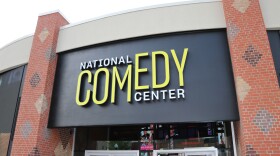The National Comedy Center holds its opening celebration in Jamestown, New York, Wednesday through Aug. 5. Once called the “furniture capital of the world,” Jamestown is the hometown of comedian and actress Lucille Ball.
Board member and comedian Lewis Black (@TheLewisBlack) has been in the museum, and joins Here & Now‘s Robin Young for a preview.
“I think it will continue to grow,” Black says. “I mean, it’s what people will see as kind of like a pilot, but it’s a pilot that will stagger them. There’s a lot of tech behind this.”
Interview Highlights
On the museum’s comedy continuum
“They give you a wristband that has a small kind of a computer chip and then it will ask you when you come in to name the comics that you like. And then it registers on that chip, and you go in.
“Let’s say you get to that comedy continuum and there’s a comic that you like in particular, you can point to that comic and then it will literally send you to a whole bunch of comics who influenced that comedian … Like, George Carlin will appear, and then somewhere along the line there, probably Jon Stewart will appear, and Dave Chappelle will appear and I’ll appear. … So, it’s kind of astonishing.”
On the use of comedians’ props in the museum, including George Carlin’s
“I mean they will probably eventually have, at some point somewhere outside, there’ll be a Jerry Seinfeld exhibit with that car [from ‘Comedians in Cars Getting Coffee’]. I mean, there’s a George Carlin room. You get a good sense of how George constructed his act or constructed a joke. There are a billion note cards that they got from Kelly Carlin [George Carlin’s daughter], who really got me involved in the project.
“And as she put it, you could take his stuff to the Smithsonian, where it might end up coming out as an exhibit once in a while and be in a backroom, or you could take it to the comedy museum, where it would be an integral part of that collection. And it’s really remarkable — his notecards with the little one-liners he would write or the thoughts that he would have. You literally stand in front of a screen and push a button and one thought will come up and then another thought will come up and a punchline will come up.”
On his own astonishment at the exhibit and the raunchiness of the Blue Room in the museum
“Now, I have sat and talked to George [Carlin] about his process, but even with that, watching him, you know, on a screen, onstage, work on a bit, as opposed to us discussing how he works, it’s amazing.
“You walk into what is called the Blue Room, which [includes] those who use language that many consider to be bad words, offensive words, shocking words, you know, the seven words that George used on television, and there’s a bar down there.
“But when you walk in, literally, the first thing you see are those words that couldn’t be said, according to the FCC. And not only are the words in English, but they’re in like eight or 10 other languages, and they take a photo of you when you see the words to show the shock that might be on your face.”
On comedy karaoke at the museum
“Instead of singing a song, there’d be a print-out, which they’d stand on a stage with [with] a mic in what is essentially a club setting that they’ve set up, in front of an audience. They’ll have Jim Gaffigan’s bits or David Attell’s bits or bits by a number of comics that are, you know, well-known and that people like. And, so you can go in and pick a bit that you like, and then you do like 50 seconds to a minute and a half of their bit.”
On a laugh battle exhibit at the museum where a facial recognition program recognizes when a person smiles or laughs, and buzzes them out
“What can happen is that two folks can sit there and try to make each other laugh and then have kind of hints on the screen of certain jokes and stuff that they might use.
“Basically, they throw things back and forth, and then Microsoft has created a recognition thing so that if the person, even if the person isn’t ‘laughing-laughing,’ but the fact that the person is really kind of starting to smile and is getting into the laugh mode, that person is buzzed out. So they nail them.”
Copyright 2021 NPR. To see more, visit https://www.npr.org.







